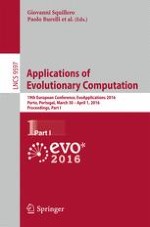The two volumes LNCS 9597 and 9598 constitute the refereed conference proceedings of the 19th European Conference on the Applications of Evolutionary Computation, EvoApplications 2016, held in Porto, Portugal, in March/April 2016, co-located with the Evo* 2016 events EuroGP, EvoCOP, and EvoMUSART.
The 57 revised full papers presented together with 17 poster papers were carefully reviewed and selected from 115 submissions. EvoApplications 2016 consisted of the following 13 tracks: EvoBAFIN (natural computing methods in business analytics and finance), EvoBIO (evolutionary computation, machine learning and data mining in computational biology), EvoCOMNET (nature-inspired techniques for telecommunication networks and other parallel and distributed systems), EvoCOMPLEX (evolutionary algorithms and complex systems), EvoENERGY (evolutionary computation in energy applications), EvoGAMES (bio-inspired algorithms in games), EvoIASP (evolutionary computation in image analysis, signal processing, and pattern recognition), EvoINDUSTRY (nature-inspired techniques in industrial settings), EvoNUM (bio-inspired algorithms for continuous parameter optimization), EvoPAR (parallel implementation of evolutionary algorithms), EvoRISK (computational intelligence for risk management, security and defence applications), EvoROBOT (evolutionary robotics), and EvoSTOC (evolutionary algorithms in stochastic and dynamic environments).
